Fun Printable Hundred Chart Activities (English, Chinese, Korean)

Want to build a strong math foundation? A printable hundred chart is one of the best teaching tools for kids. Counting, patterns, addition, subtraction, multiplication – kids can learn basic math from a hundred chart. Your child or student can enjoy simple Montessori hundred chart activities at home or school.
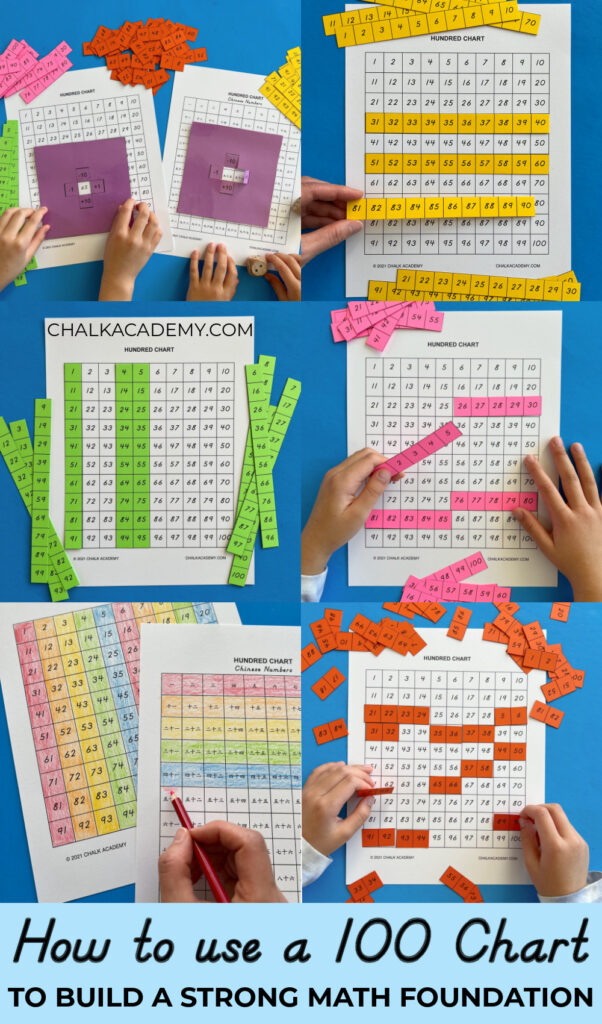
Since we’re raising multilingual children, I created a hundred chart printable with three language versions:
- Arabic numerals 1, 2, 3 (also known as European digits)
- Chinese numerals 一二三 (yī’èrsān)
- Korean numbers (Sino Korean & Native Korean)
In addition to basic math, our printable hundred chart allows children to work on their oral and written language skills simultaneously.
Try this: How to Teach Kids Basic Math for Free
Chalk Academy is reader-supported. Some of the links are affiliate links. When you buy something through an affiliate link, we may earn a very small commission at no cost to you. Details here.
At what age can a child start using a printable hundred chart?
A hundred chart is so versatile. It can be used by toddlers, preschoolers, kindergartners, and even elementary-aged children! For instance, toddlers can use it to learn how to count. Meanwhile, elementary school kids can use a printable hundred chart to learn about money.
Learning during early childhood can vary greatly from kid to kid – even siblings! For example, one of my children started using our hundreds chart at age three. My other child began to have fun with the hundreds chart at the age of five years. And many kids continue to use a hundreds chart in first, second, and third grade.
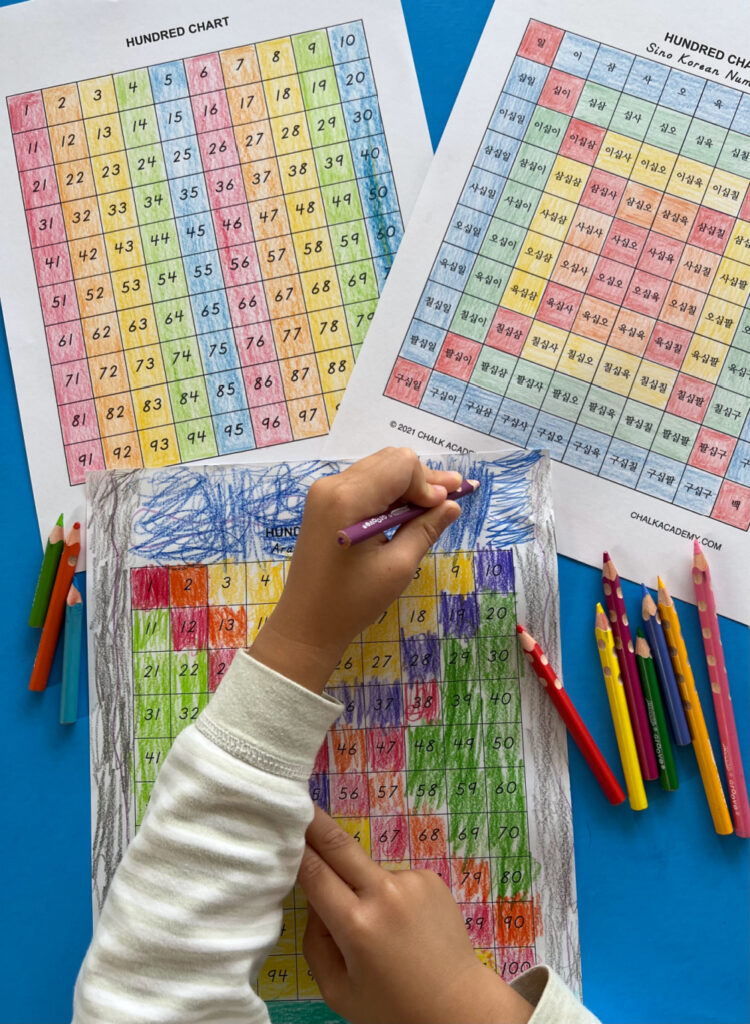
What kids should know before using a printable hundreds chart
Before introducing the hundreds chart, kids should be able to count verbally. They should also understand one-to-one correspondence.
For example, they should understand that number 1 represents one object, number 2 represents two objects, and so on. These concrete concepts are needed before focusing on abstract number symbols.
You can practice verbal counting with this DIY spindle box.
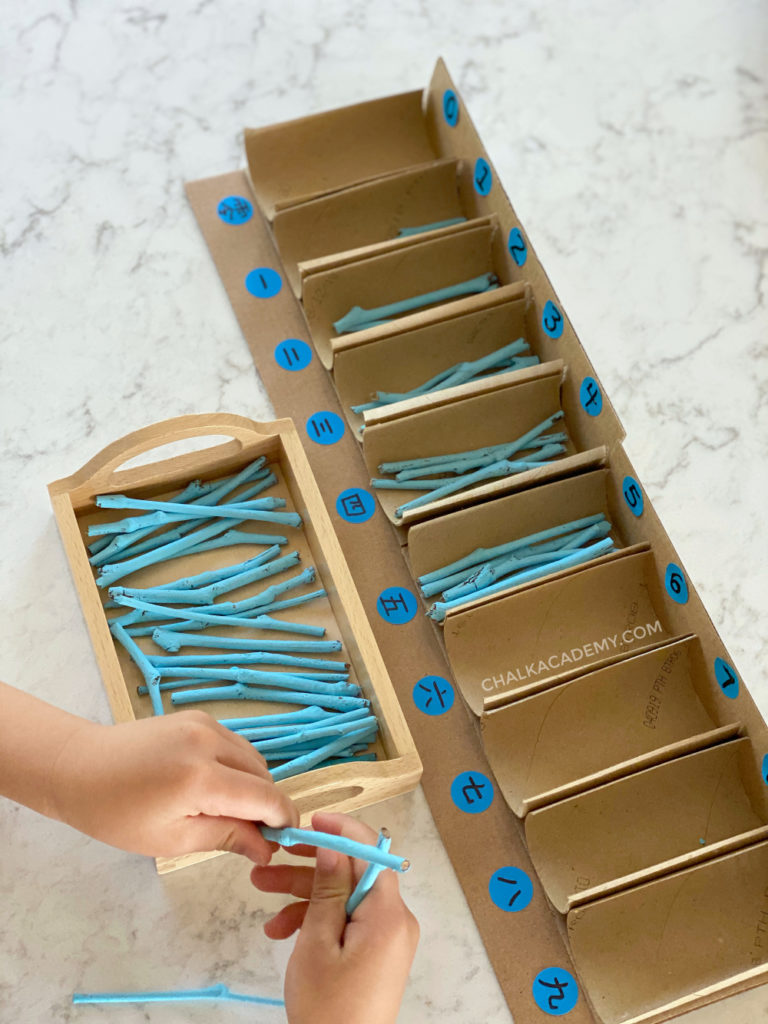
How to simplify a printable hundred chart for younger kids
In the beginning, the whole page of numbers can be overwhelming. If that’s the case – no worries! You can make the chart smaller and less intimidating by cutting out numbers 1-10.
Remember, everyone has different learning speeds! Only move on to bigger numbers when your child seems curious and confident. Once a child has mastered numbers 1-10, try 1-20. Gradually work your way up to the full 100 chart.
Which language should bilingual kids use to learn to count?
Kids can learn how to count in multiple languages simultaneously. They have amazingly absorbent brains. Our family has even used all of our hundreds charts and languages simultaneously!
While kids can learn languages in any order, it’s best to focus on speaking the minority language first. This is because children spend most of their childhood immersed in the dominant community language, especially once they enroll in school full-time.
Download printable hundred charts in English, Chinese, or Korean
To save you time when teaching your child basic math, I have a hundred chart printables ready for you!
Since math resources are tough to find in Chinese and Korean, I want to knock down the barriers for families like ours. I’ve created three hundred charts for your children to learn math in your target language.
Download and print them with these links:
Make sure to save the printable hundred chart to your computer. That way, you can print off multiple copies whenever you need them. I have many different methods for using the chart below, so you want to have plenty of copies to try them all!
Other recommended supplies
- White printer paper
- Colorful printer paper
- Scissors and/or paper trimmer
- Optional:
15 fun ways to teach math with a hundred chart printable
Here are just a few ideas that your child can try!
Introduce counting and reading numbers
Modeling how to read a hundreds chart is the foundational step. Show your child or student how to start from 1, read from left to right, and then go row-by-row.
Make a number-matching puzzle
With colored card stock paper, print extra copies of the hundred chart. Then, cut the colorful paper into strips and different shapes for your child to piece together the number-matching puzzle!
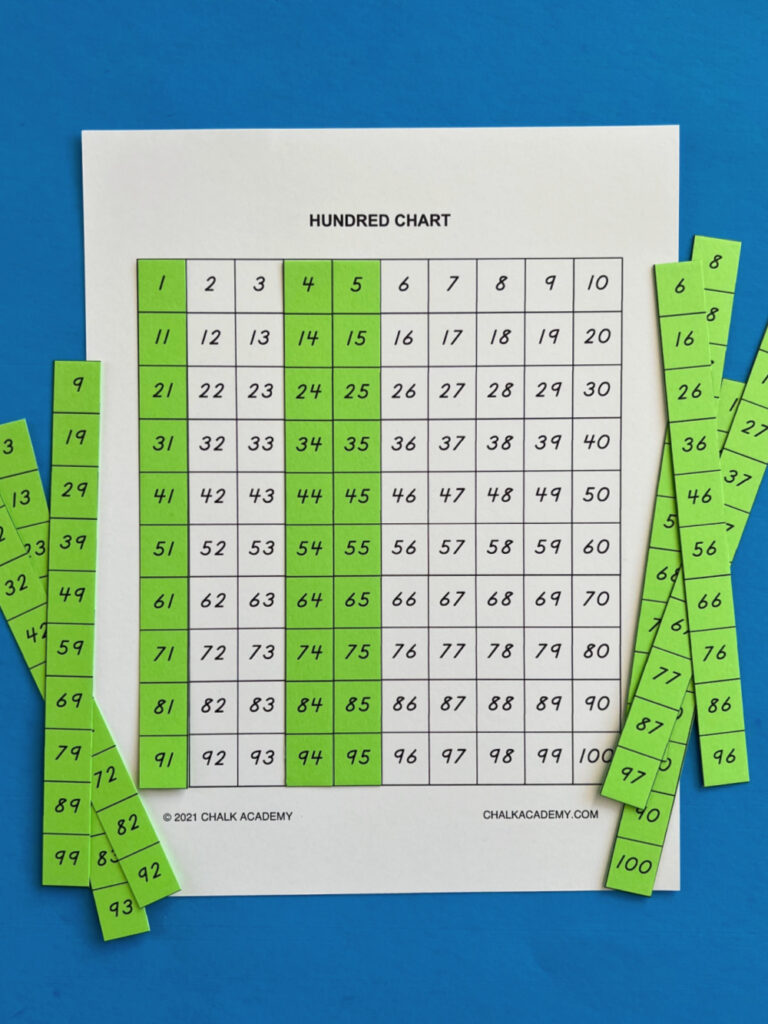
Practice skip counting
Here’s another way to use the colorful card stock paper again! Print extra copies of the hundreds chart. Then, use scissors or a paper trimmer to cut and split the numbers into doubles, 5s, and 10s.
Skip counting by 2 / multiplication by 2
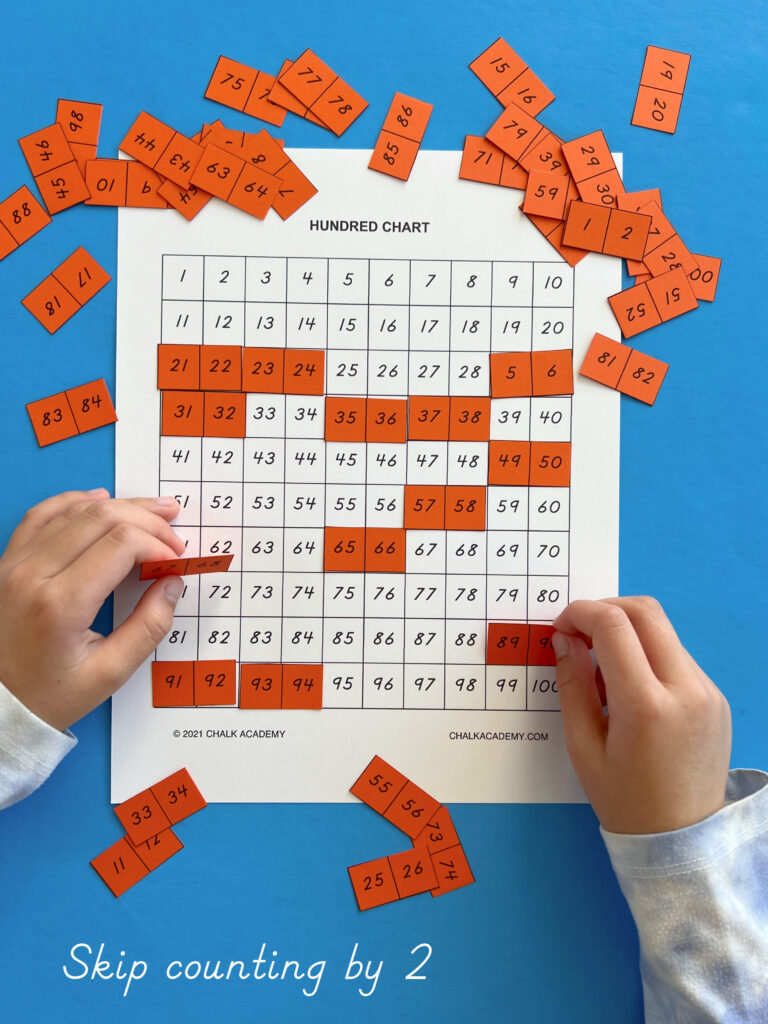
Skip counting by 5 / multiplication by 5
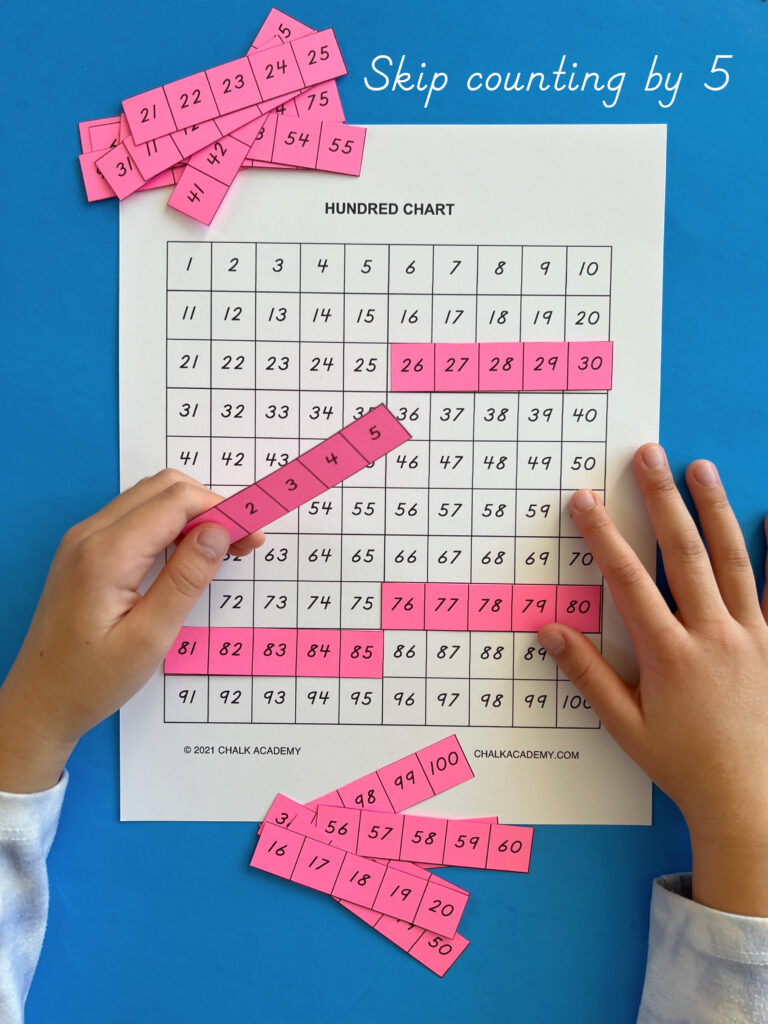
Skip count by 10 / Multiplication by 10
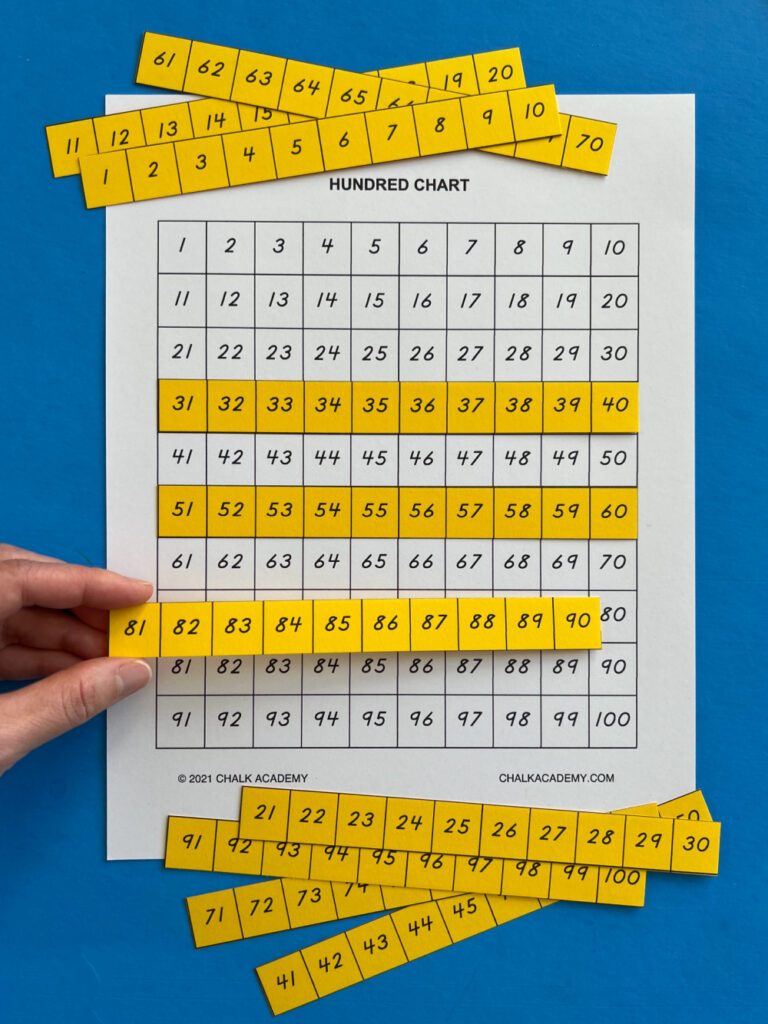
Learn basic addition and subtraction
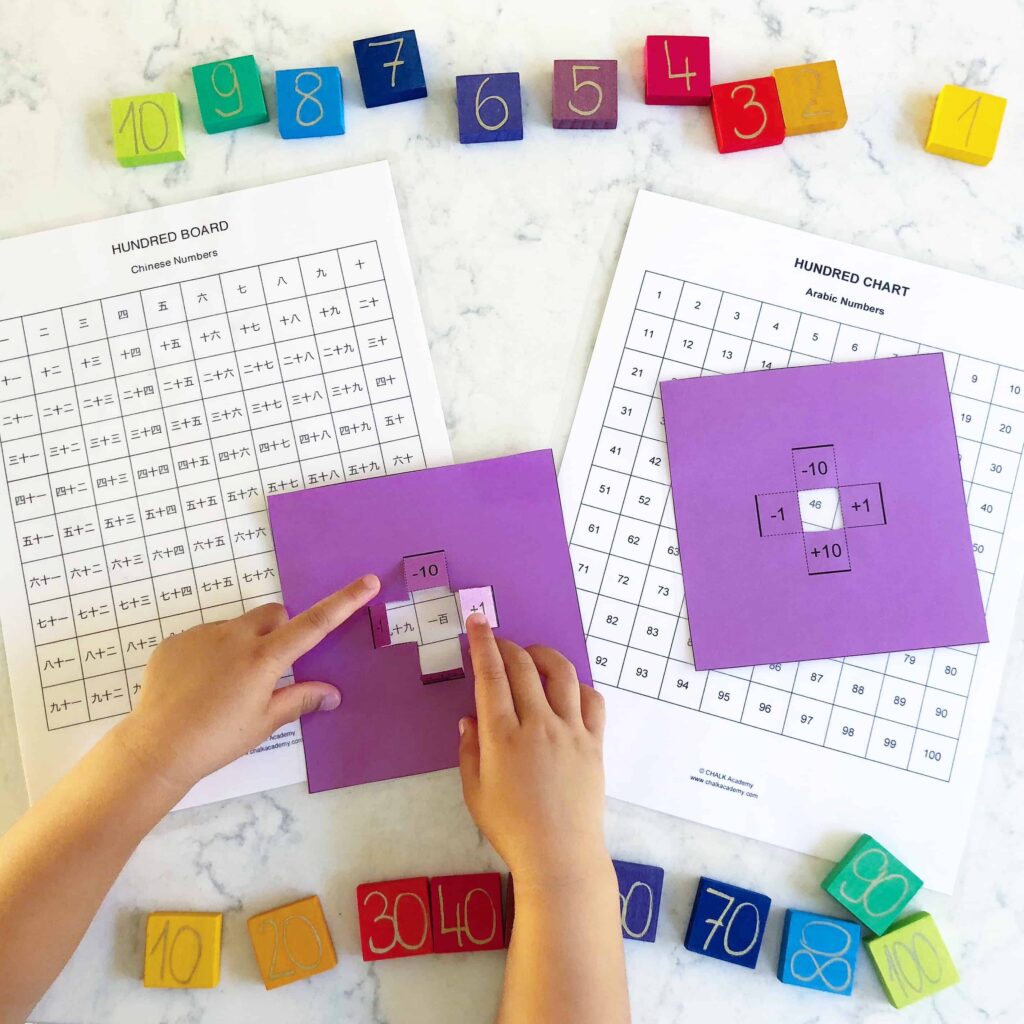
Using our template, cut a window with an X-Acto knife and practice adding and subtracting by 1 or 10.
Use the printable hundred chart as a coloring page
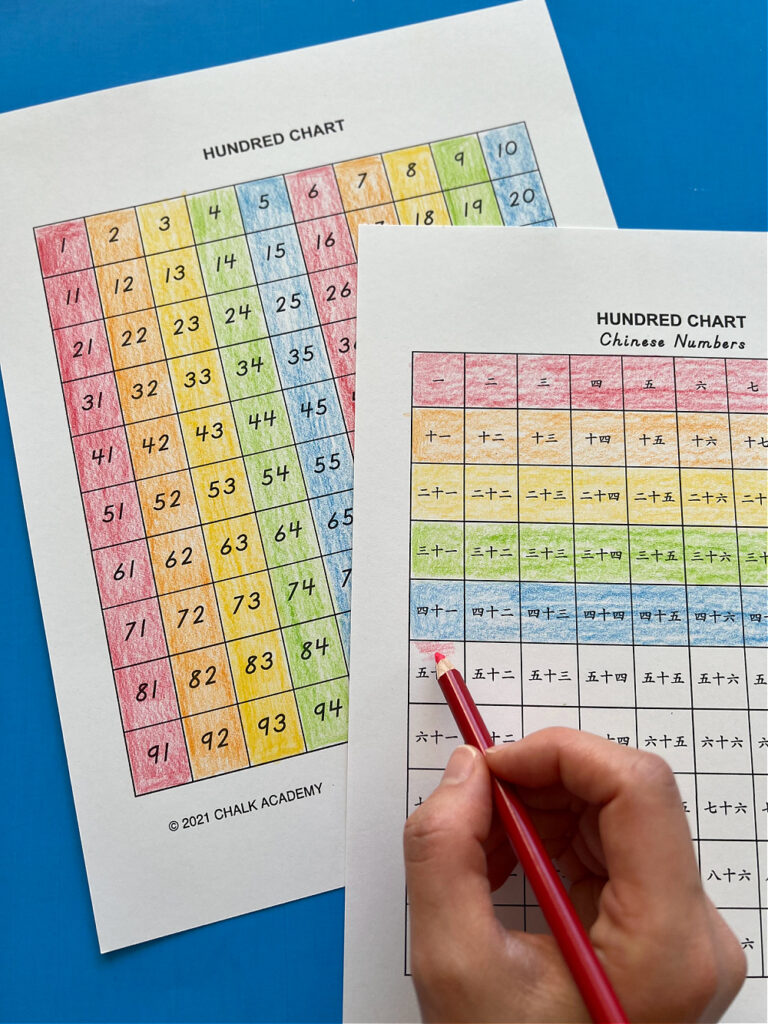
Adding pencil crayons and colors is one of the best ways to get kids involved who may not feel enthusiastic about math. With colored pencils, create a rainbow and colorful patterns with even numbers, odd numbers, and multiples!
Race to 100!
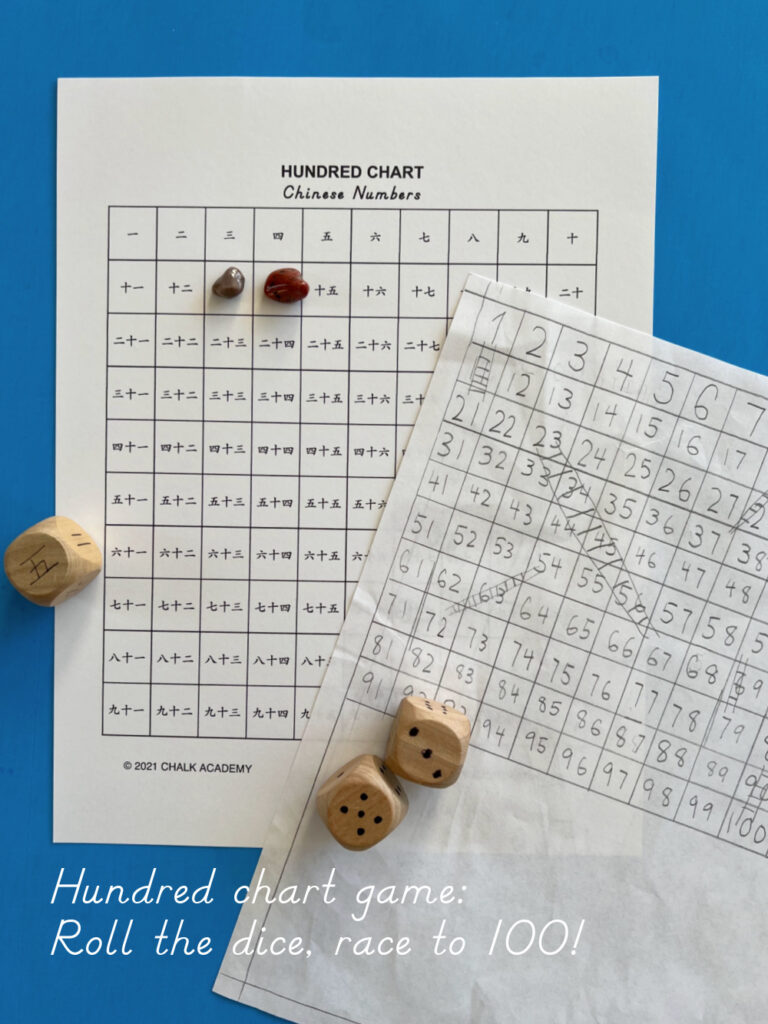
Race with small rocks, pom poms, beans, pennies, or other small objects! Roll the dice, and move the small object X number of spaces according to the dice. See who gets to 100 first!
Essentially, this is a basic version of Snakes and Ladders. You can even draw snakes and ladders like my kids did in the picture above! It adds more variety to the game when you’ve already played a simple round.
Create letters and numbers with dot stickers

Cover numbers with stickers in a cool pattern, and guess the matching numbers! For this activity, I like to laminate our printable hundred charts so the chart can be reused after the stickers are peeled off.
As kids grow up, they can practice writing in numbers and peeling back the stickers to see if they’re correct.
Make shapes and patterns with dot stickers
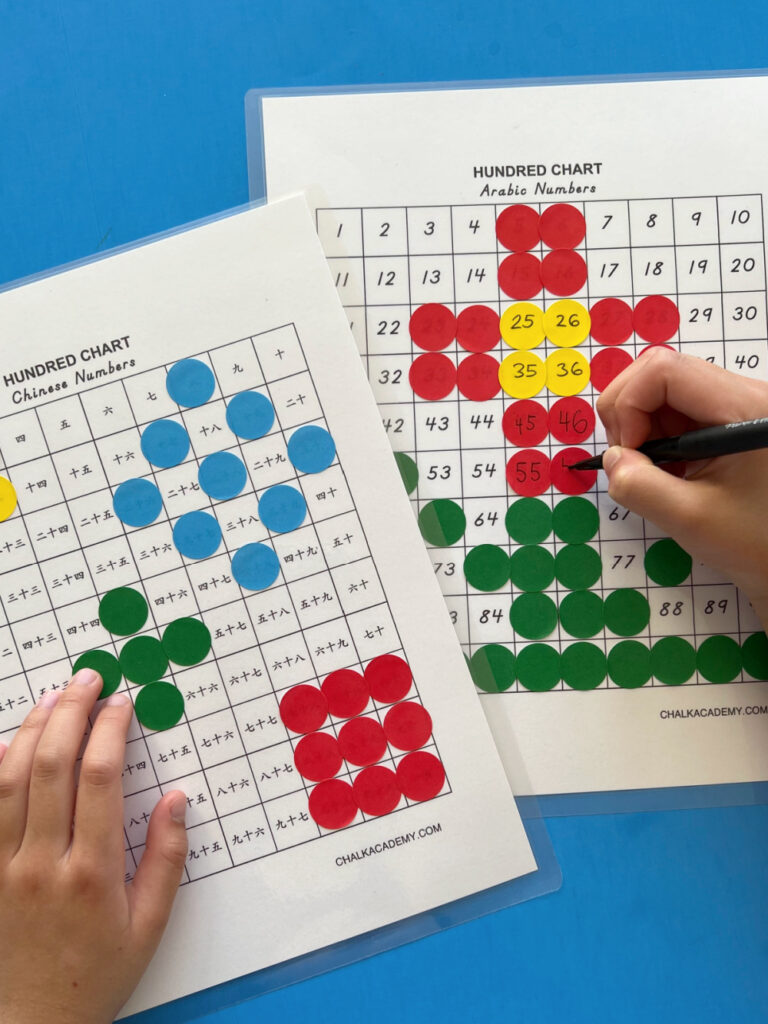
If your child is a sticker lover, you can create many shapes and patterns! We’ve used dot stickers to make shapes, flowers, and even a Christmas tree. Write in the number that’s covered, and peel off the sticker to check your answer. As shown below, dot stickers can also be used for skip-counting practice.
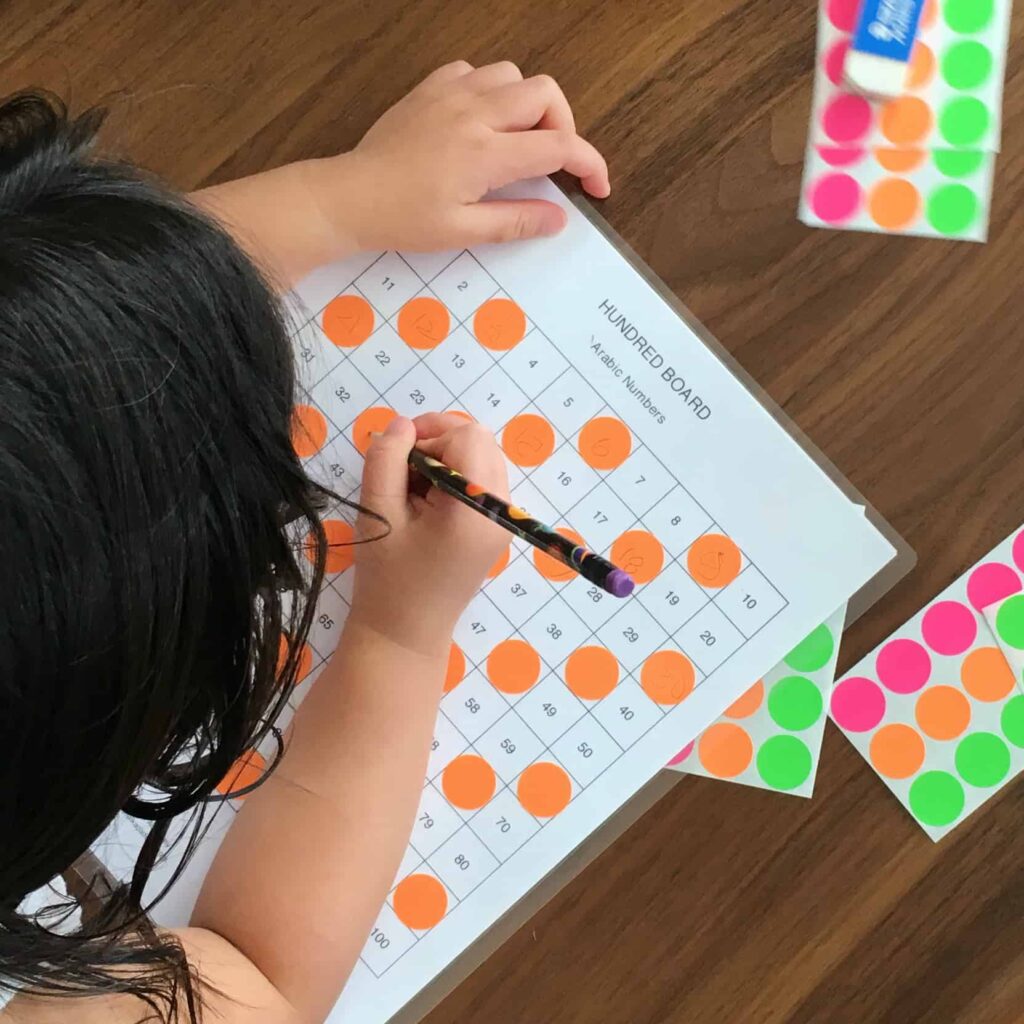
Related: 30 Chinese Dot Sticker Learning Activities for Kids (Printables)
Learn about money
When your child has mastered counting to 100, the hundreds chart be used to help teach money math. Use pennies, nickels, dimes, and quarters with the hundreds chart! This can be a fun, hands-on way to learn about the value of each coin.
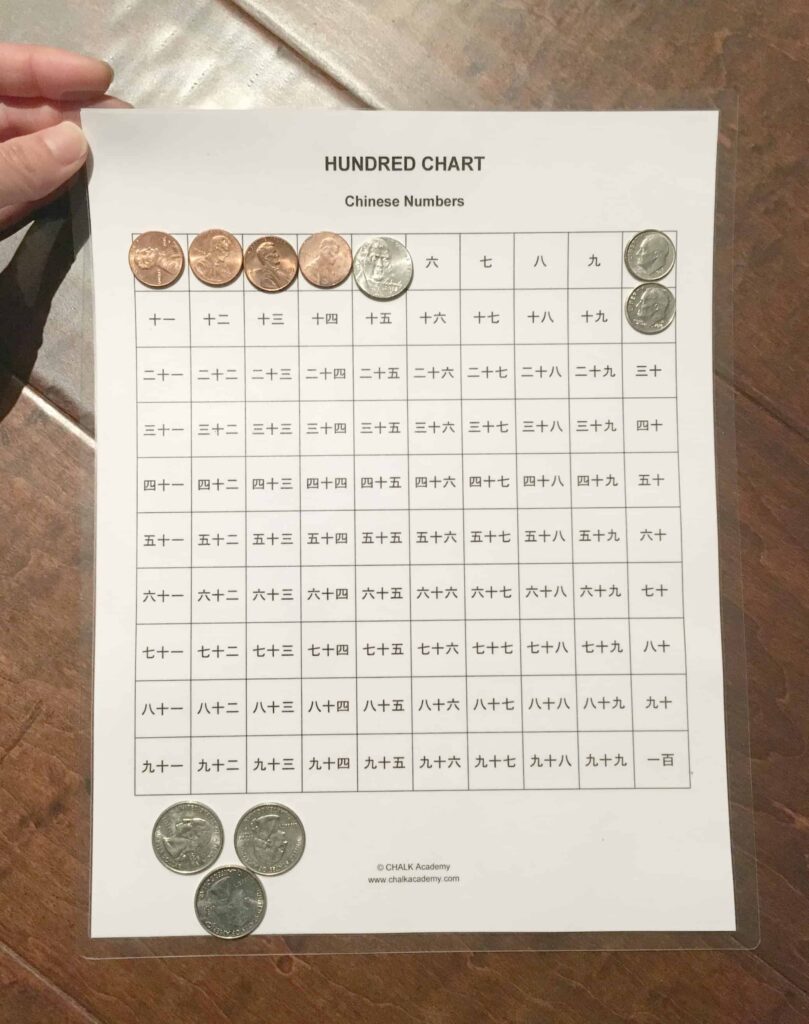
Play with math link cubes
These popular mathlink cubes perfectly fit the squares on our printable hundred chart. They can be linked together to count by pairs or other groups, and the sides of each cube have geometric shapes. This adds a little more excitement and hands-on activity to your child’s counting.
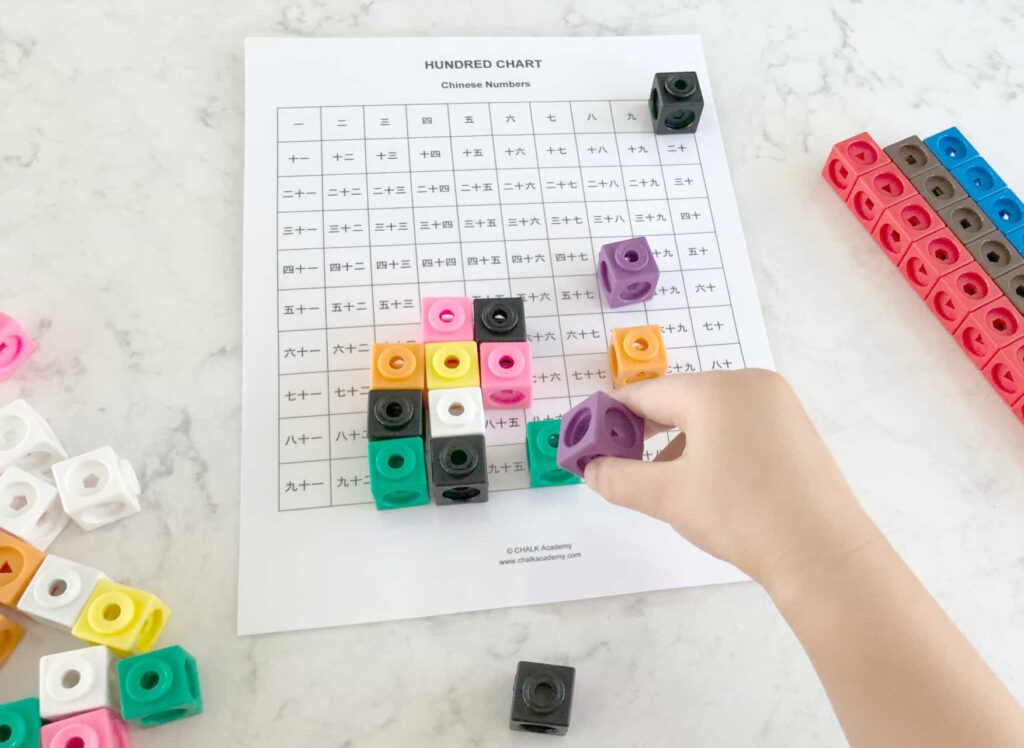
Mix multiple languages together!
Celebrate your family’s languages with the hundred chart! If your children are bilingual or multilingual, the hundreds chart is a fun way to compare and learn math with all their languages.
Just for fun, I remember my daughter would start counting in Chinese, switch to Korean, and finish in English. Hearing her switch fluidly between languages is a fascinating brain workout!
Get the printable 100 Chart here!
Montessori hundred board
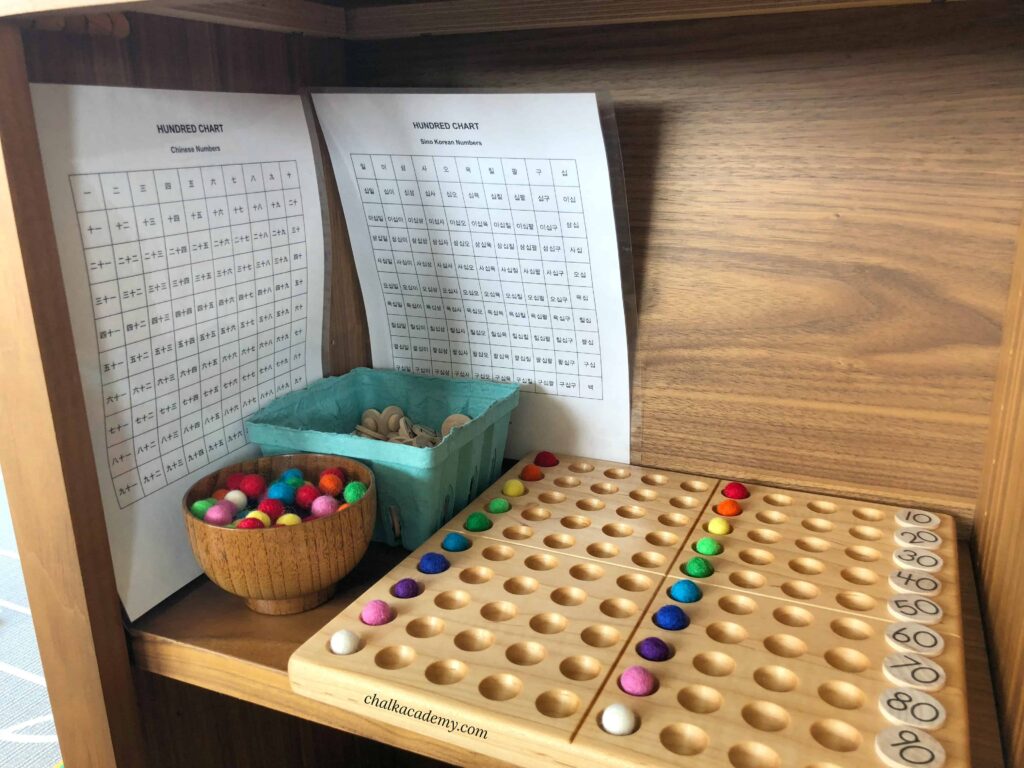
If you want something even more hands-on, check out our review of the versatile wood hundred board!
More ways to have fun learning Montessori math
- Our Favorite Hands-on Montessori-Inspired Learning Tools
- Montessori Pythagoras Board and Bilingual Multiplication Table (English and Chinese)
- Montessori Multiplication and Division Boards